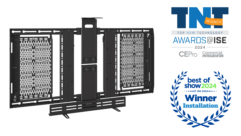POV: Pathway to AV Sustainability
Jan 1, 2009 12:00 PM,
By Randal A. Lemke, Ph.D.
As AV has become integral to organizations’ communication infrastructure, AV has become a major component of the building industry. The built environment has incorporated our technologies and systems, and the success of the AV industry will increasingly depend on our ability to contribute to and be a partner with the other members of the building industry.
Architects, MEP firms, general contractors, lighting contractors, and others in the built environment are deeply involved in the green movement — particularly in the many buildings that are seeking LEED certification. With a short history, the United States Green Building Council (USGBC) has become the standard-setter for applications of green technologies and processes for commercial and residential structures.
AV design professionals are increasingly being asked to participate in scoring sessions to evaluate the potential buildings have to achieve one of four levels of LEED certification. As of today, there are no criteria that point toward AV, so AV brings no instant value to the LEED rating of a project. Through innovation points, AV could contribute. So far, however, no AV points have been granted that can serve as a precedent for future buildings. While not contributing could be seen as a non-issue for the industry, the potential is there that, in the future, AV will be seen as a negative because of its many electrical devices and lack of recycled products. Becoming green may not be an option in the future — it may be a necessity if we are to work and thrive in the built environment.
AV also is a big part of the live-events industry, and it faces a similar challenge to become green. Tradeshows, product roll-outs, conventions, and the rest of the meeting industry have become a larger purchaser of AV staging services. Many of those events are now being organized by groups such as the Green Meetings Industry Council that have taken on the task of running green meetings. New guidelines being developed by the U.S. Environmental Protection Agency in partnership with the Convention Industry Council’s Accepted Practices Exchange will mandate changes for the AV staging industry if they want to service green meetings and events. From the reduction in energy usage, the substitution of new recyclable products, and the use of conferencing technologies, the movement to lower the carbon footprint of meetings is well underway.
On Oct. 23, 2008, InfoComm members discussed the current and future position of AV in the green movement. The AV Summit members identified six areas where the AV industry can contribute to a sustainable future, including lighting control and devices, Energy Star/energy consumption, green processes and products, control systems, videoconferencing, and digital signage.
These initial six areas and the explanatory examples can form a foundation for green AV. In the future, there will surely be more areas of action and the number of examples will multiply. These areas of action will be important for both the built environment as well as the meeting industry. InfoComm has created a green AV task force to create sustainable AV best practices and to work with InfoComm’s education and advocacy programs to educate industry members and their customers and interested parties on these practices.
In the coming months, look for more information on this important initiative. Please visit InfoComm’s community website, community.infocomm.org, for more information on how you can get involved with green AV.
Randal A. Lemke, Ph.D, is executive director of InfoComm International.










